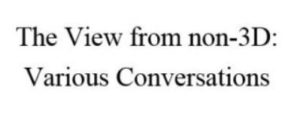
From Symbols of Transformation, by Carl Gustav Jung
Any intensive train of thought works itself out more or less in verbal forms – if, that is to say, one wants to express it, or teach it, or convince someone of it. it is evidently directed outwards, to the outside world. To that extent, directed or logical thinking is reality-thinking, or thinking that is adapted to reality, by means of which we imitate the successiveness of objectively real things, so that the images inside our mind follow one another in the same strictly causal sequence as the events taking place outside it…. In biological terms it is simply a process of psychic assimilation that leaves behind a corresponding state of exhaustion, like any other vital achievement.
C,G. Jung, Symbols of Transformation, pp 11-12
Re-reading that several times does at length produce understanding – but it is a struggle (as promised!). As Henry Ford said, thinking is the hardest work there is, which is why so few people do it. [5-29-13]
Directed thinking or, as we might also call it, thinking in words, is manifestly an instrument of culture …. The secret of cultural development is the mobility and disposability of psychic energy. Directed thinking is a more or less modern acquisition which earlier ages lacked.
CGJ, S of T, p 16
The alternative form of thinking is association thinking, non-directed, a train of images. He quotes William James as saying, “As a rule, in this sort of irresponsible thinking, the terms which come to be coupled together are empirical concretes, not abstractions.” [5-30-13]
We can supplement James’s definitions by saying that this sort of thinking does not tire us, that it leads away from reality into fantasies of the past or future. At this point thinking in verbal form ceases, image piles on image, feeling on feeling, and there is an ever-increasing tendency to shuffle things about and rearrange them not as they are in reality but as one would like them to be…. Common speech calls this kind of thinking “dreaming.”
CGJ, S of T, pp 17-18
Fantasy-thinking is dream language, he says. Children live in it. it appears that Nietzsche, Freud and Jung all believed that dreams are vestiges of earlier ways of thinking – before man developed directed thinking. It is found, he says, in children, primitives, and dreams. And myths were produced by the type of thinking that now produces dreams. What’s more:
We now know that this same thinking also occupies a large place in modern man and appears as soon as directed-thinking ceases. Any lessening of interest, or the slightest fatigue, is enough to put an end to the delicate psychological adaptation to reality which is expressed through directed thinking, and to replace it by fantasies. We wander from the subject and let our thoughts go their own way; if the slackening of attention continues, we gradually lose all sense of the present, and fantasy gains the upper hand.
CGJ, S of T, p 25